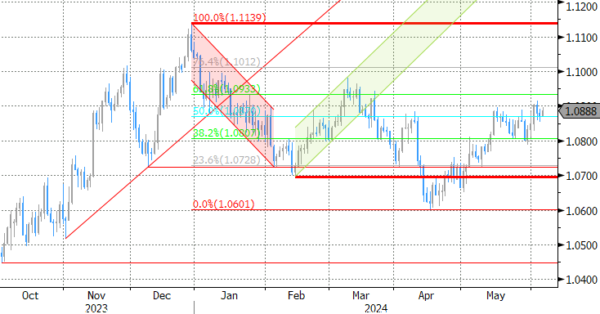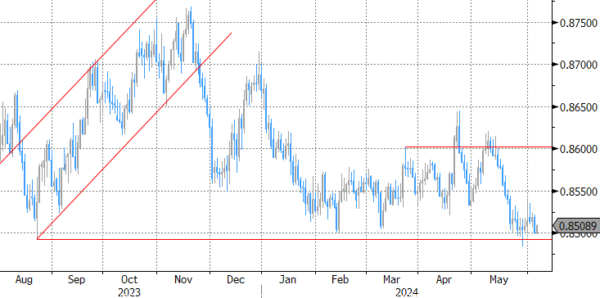Markets
Make it five. Five consecutive days of rallying US Treasuries on the (consequences of) the same theme: fading growth momentum and what it might mean to the Fed. At the front end of the curve, we’ve seen the obvious swing back from a first cut in December to the Fed pulling the trigger already in September. The US 2-yr yield lost 25 bps on a weekly basis. The long end of the curve outperformed, shedding up to 34 bps for the US 10-yr yield as real rates drove the move lower. The US 10-yr yield closed just below 4.31% support yesterday as the balance between a slightly below consensus ADP employment report (+152k vs +175k) and the Bank of Canada leaving the door open for follow-up action after their first rate cut this cycle on the one hand and a stronger-than-hoped for rebound in the services ISM (53.8 from 49.4 vs 51 expected) and bullish risk sentiment (WS up to +2% for Nasdaq) on the other hand, eventually fell in favour of the former. It’s telling about very short term bond market sentiment given broad-based strength in ISM subcomponents. Business activity surged (61.2) and new order growth accelerated (54.1), also for export orders (61.8). Firms still cut jobs, but at a slower pace (47.1). The prices paid component softened somewhat compared to April, but at 58.1 still suggests abundant inflationary pressures. Today is this week’s odd one out from a data point of view unless we see a significant surprise in Q1 (final) productivity and labor cost data. Tomorrow, May payrolls have the final say.
Focus turns to Europe and to the ECB today. They’ll join the Bank of Canada in making monetary policy less restrictive with a well-flagged 25 bps rate cut for all policy rates. The bigger question remains whether the central bank commits to any guidance for the following meetings, something they refused to do so far. Back in March when presenting their new operational framework, they did already flag to narrow the corridor between the main refinancing rate and the deposit rate from currently 50 bps to 15 bps. The penalty rate (MLF) will remain 25 bps above the MRO. Sticky Q1 wage growth, the bumpy inflation path ahead, recovering economic growth, and the Fed’s reaction function all suggest limited scope for genuine follow-up rate cuts. We nevertheless think that the ECB will keep the option open and that the market will anticipate. Current market pricing (2.5 rate cuts discounted for this year) seems prone for a dovish repositioning at the front end of the curve in a steepening move. This should keep EUR/USD below 1.09 resistance and will trigger (at least) a test of EUR/GBP 0.85 support.
News & Views
The National Bank of Poland (NBP) left its main policy rate unchanged at 5.75% yesterday. Headline inflation printed at 2.5% in May, exactly touching the NBP’s inflation target. Core inflation (4.1% in April) is also expected to have decreased further. A further decline in producer prices (-8.6% Y/Y in April) confirms the fading of most external supply shocks and a reduction of cost pressures. Together with relatively low economic growth, it limits inflation. The strong zloty also helps. The NBP expects that Q2 annual CPI growth will run consistent with the its inflation target. Core CPI is also seen declining further, but due to elevated services inflation, it will stay above the headline inflation. Despite current favorable inflation developments, the NBP continues to see a high degree of uncertainty for inflation beyond Q2 related to the impact of fiscal and regulatory price policies which might also affect inflation expectations. Higher domestic demand due to rising wages is mentioned as a potential factor for higher inflation in H2 as well. Governor Glapinski will comment the policy decision in a press conference later today.
The Bank of Canada (BoC) cut its policy rate by 25 bps to 4.75%. The Canadian economy returned to growth (1.7%) in Q1, but this was softer than the BOC expected even as consumption was solid. Wage pressures remain but look to be moderating gradually. Overall, recent data suggest the economy is still operating in excess supply. CPI inflation eased to 2.7%. Core inflation also slowed and is expected to hold a downward momentum. The Governing Council agreed that monetary policy no longer needs to be as restrictive as it was. Going forward governor Macklem indicated that “If inflation continues to ease, and our confidence that inflation is headed sustainably to the 2% target continues to increase, it is reasonable to expect further cuts to our policy interest rate,” Macklem admitted that there are limits to how far the BoC can diverge from the US, but that they are not close to those limits yet.
Graphs
GE 10y yield
ECB President Lagarde clearly hinted at a June rate cut which has broad backing. A more bumpy inflation path in H2 2024, the EMU economy gradually regaining traction and the Fed’s higher for longer US strategy make follow-up moves difficult. Markets are coming to terms with that. The German 10y yield set a new YtD top at 2.7% before following the US correction lower on growth worries
US 10y yield
The Fed in May acknowledged the lack of progress towards the 2% inflation objective, but Fed Chair Powell indicated that further tightening was unlikely. However, the FOMC Minutes still showed internal debate on whether policy is restrictive enough. Sticky inflation suggests any rate cut will be a tough balancing act while several policy makers hint at a higher neutral rate. The US 10-y yield is correcting lower in the 4.3/4.7% trading range.
EUR/USD
Economic divergence, a likely desynchronized rate cut cycle with the ECB exceptionally taking the lead and higher than expected US CPI data pushed EUR/USD to the 1.06 area. From there, better EMU data gave the euro some breathing space. The dollar lost further momentum on softer than expected early May US data. Some further consolidation in the 1.06/1.09 area might be on the cards short-term.
EUR/GBP
Debate at the Bank of England is focused at the timing of rate cuts. Slower than expected April disinflation and a surprise general election on July 4 suggest that a June cut in line with the ECB looks improbable. Sterling gained momentum with money markets now discounting a Fed-like scenario. EUR/GBP tested the 2023 & 2024 lows near 0.85. We expect this important support level to hold.
















